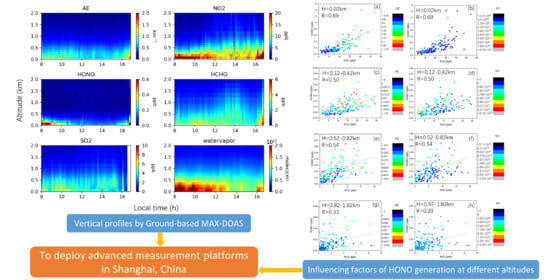Observations by Ground-Based MAX-DOAS of the Vertical Characters of Winter Pollution and the Influencing Factors of HONO Generation in Shanghai, China
Abstract
:1. Introduction
2. Materials and Methodologies
2.1. The MAX-DOAS Observations
2.1.1. Setup of Observations
2.1.2. Spectral Analysis
2.1.3. Profile Retrievals of Aerosol and Trace Gases
2.2. Backward Trajectory
2.3. TUV Model
2.4. Ancillary Data for Validation
3. Results
3.1. Validation of VCDs Measured by MAX-DOAS
3.2. Validation of Surface Concentrations Measured by MAX-DOAS
3.3. Vertical Distribution Characters and Diurnal Variations of Tropospheric Aerosol Extinction, NO2, HONO, HCHO, SO2, and Water Vapor
4. Discussion
4.1. Trajectory Clustering and Potential Pollution Evolution
4.2. Vertical Characters of Tropospheric HONO
4.3. The Impact Factors on HONO Formation at Different Altitude
4.4. Contribution of OH Production from HONO Photolysis at Different Altitude
5. Conclusions and Summaries
Supplementary Materials
Author Contributions
Funding
Data Availability Statement
Acknowledgments
Conflicts of Interest
References
- Kampa, M.; Castanas, E. Human health effects of air pollution. Environ. Pollut. 2008, 151, 362–367. [Google Scholar] [CrossRef]
- Anderson, J.O.; Thundiyil, J.G.; Stolbach, A. Clearing the air: A review of the effects of particulate matter air pollution on human health. J. Med. Toxicol. 2012, 8, 166–175. [Google Scholar] [CrossRef] [Green Version]
- Gurjar, B.; Jain, A.; Sharma, A.; Agarwal, A.; Gupta, P.; Nagpure, A.; Lelieveld, J. Human health risks in megacities due to air pollution. Atmos. Environ. 2010, 44, 4606–4613. [Google Scholar] [CrossRef]
- Lave, L.B.; Seskin, E.P. Air pollution and human health. Science 1970, 169, 723–733. [Google Scholar] [CrossRef] [Green Version]
- He, J.; Gong, S.; Yu, Y.; Yu, L.; Wu, L.; Mao, H.; Song, C.; Zhao, S.; Liu, H.; Li, X. Air pollution characteristics and their relation to meteorological conditions during 2014–2015 in major Chinese cities. Environ. Pollut. 2017, 223, 484–496. [Google Scholar] [CrossRef]
- Huang, Y.; Yao, T.; Fung, J.C.; Lu, X.; Lau, A.K. Application of air parcel residence time analysis for air pollution prevention and control policy in the Pearl River Delta region. Sci. Total Environ. 2019, 658, 744–752. [Google Scholar] [CrossRef] [PubMed]
- Wang, J.; Qu, W.; Li, C.; Zhao, C.; Zhong, X. Spatial distribution of wintertime air pollution in major cities over eastern China: Relationship with the evolution of trough, ridge and synoptic system over East Asia. Atmos. Res. 2018, 212, 186–201. [Google Scholar] [CrossRef]
- Zhao, X.; Zhao, P.; Xu, J.; Meng, W.; Pu, W.; Dong, F.; He, D.; Shi, Q. Analysis of a winter regional haze event and its formation mechanism in the North China Plain. Atmos. Chem. Phys. 2013, 13, 5685–5696. [Google Scholar] [CrossRef] [Green Version]
- Yin, H.; Sun, Y.W.; Liu, C.; Lu, X.; Smale, D.; Blumenstock, T.; Nagahama, T.; Wang, W.; Tian, Y.; Hu, Q.H.; et al. Ground-based FTIR observation of hydrogen chloride (HCl) over Hefei, China, and comparisons with GEOS-Chem model data and other ground-based FTIR stations data. Opt. Express 2020, 28, 8041–8055. [Google Scholar] [CrossRef]
- Yin, H.; Sun, Y.W.; Liu, C.; Zhang, L.; Lu, X.; Wang, W.; Shan, C.G.; Hu, Q.H.; Tian, Y.; Zhang, C.X.; et al. FTIR time series of stratospheric NO2 over Hefei, China, and comparisons with OMI and GEOS-Chem model data. Opt. Express 2019, 27, A1225–A1240. [Google Scholar] [CrossRef]
- Yin, H.; Sun, Y.; Song, Z.; Liu, C.; Wang, W.; Shan, C.; Zha, L. Remote Sensing of Atmospheric Hydrogen Fluoride (HF) over Hefei, China with Ground-Based High-Resolution Fourier Transform Infrared (FTIR) Spectrometry. Remote Sens. 2021, 13, 791. [Google Scholar] [CrossRef]
- Li, L.; Chen, C.; Fu, J.; Huang, C.; Streets, D.; Huang, H.; Zhang, G.; Wang, Y.; Jang, C.; Wang, H. Air quality and emissions in the Yangtze River Delta, China. Atmos. Chem. Phys. 2011, 11, 1621–1639. [Google Scholar] [CrossRef] [Green Version]
- Hao, N.; Valks, P.; Loyola, D.; Cheng, Y.; Zimmer, W. Space-based measurements of air quality during the World Expo 2010 in Shanghai. Environ. Res. Lett. 2011, 6, 044004. [Google Scholar] [CrossRef] [Green Version]
- Xing, C.; Liu, C.; Wang, S.; Chan, K.L.; Gao, Y.; Huang, X.; Su, W.; Zhang, C.; Dong, Y.; Fan, G. Observations of the vertical distributions of summertime atmospheric pollutants and the corresponding ozone production in Shanghai, China. Atmos. Chem. Phys. 2017, 17, 14275–14289. [Google Scholar] [CrossRef] [Green Version]
- Harrison, R.M.; Peak, J.D.; Collins, G.M. Tropospheric cycle of nitrous acid. J. Geophys. Res. Atmos. 1996, 101, 14429–14439. [Google Scholar] [CrossRef]
- Li, D.; Xue, L.; Wen, L.; Wang, X.; Chen, T.; Mellouki, A.; Chen, J.; Wang, W. Characteristics and sources of nitrous acid in an urban atmosphere of northern China: Results from 1-yr continuous observations. Atmos. Environ. 2018, 182, 296–306. [Google Scholar] [CrossRef] [Green Version]
- Fu, X.; Wang, T.; Zhang, L.; Li, Q.; Wang, Z.; Xia, M.; Yun, H.; Wang, W.; Yu, C.; Yue, D. The significant contribution of HONO to secondary pollutants during a severe winter pollution event in southern China. Atmos. Chem. Phys. 2019, 19, 1–14. [Google Scholar] [CrossRef] [Green Version]
- Hönninger, G.; Friedeburg, C.V.; Platt, U. Multi axis differential optical absorption spectroscopy (MAX-DOAS). Atmos. Chem. Phys. 2004, 4, 231–254. [Google Scholar] [CrossRef] [Green Version]
- Bobrowski, N.; Hönninger, G.; Galle, B.; Platt, U. Detection of bromine monoxide in a volcanic plume. Nature 2003, 423, 273–276. [Google Scholar] [CrossRef]
- Wagner, T.; Dix, B.V.; Friedeburg, C.V.; Frieß, U.; Sanghavi, S.; Sinreich, R.; Platt, U. MAX-DOAS O4 measurements: A new technique to derive information on atmospheric aerosols—Principles and information content. J. Geophys. Res. Atmos. 2004, 109. [Google Scholar] [CrossRef] [Green Version]
- Wittrock, F.; Oetjen, H.; Richter, A.; Fietkau, S.; Medeke, T.; Rozanov, A.; Burrows, J. MAX-DOAS measurements of atmospheric trace gases in Ny-Ålesund-Radiative transfer studies and their application. Atmos. Chem. Phys. 2004, 4, 955–966. [Google Scholar] [CrossRef] [Green Version]
- Xing, C.; Liu, C.; Wang, S.; Hu, Q.; Liu, H.; Tan, W.; Zhang, W.; Li, B.; Liu, J. A new method to determine the aerosol optical properties from multiple-wavelength O4 absorptions by MAX-DOAS observation. Atmos. Meas. Tech. 2019, 12, 3289–3302. [Google Scholar] [CrossRef] [Green Version]
- Cheng, Y.; Wang, S.; Zhu, J.; Guo, Y.; Zhang, R.; Liu, Y.; Zhang, Y.; Yu, Q.; Ma, W.; Zhou, B. Surveillance of SO2 and NO2 from ship emissions by MAX-DOAS measurements and the implications regarding fuel sulfur content compliance. Atmos. Chem. Phys. 2019, 19, 13611–13626. [Google Scholar] [CrossRef] [Green Version]
- Wang, G.; Wang, J.; Xin, Y.; Chen, L. Transportation pathways and potential source areas of PM10 and NO2 in Tianjin. China Environ. Sci. 2014, 34, 3009–3016. [Google Scholar]
- Wang, J.; Zhang, X.; Guo, J.; Wang, Z.; Zhang, M. Observation of nitrous acid (HONO) in Beijing, China: Seasonal variation, nocturnal formation and daytime budget. Sci. Total Environ. 2017, 587, 350–359. [Google Scholar] [CrossRef]
- Chance, K.; Kurucz, R.L. An improved high-resolution solar reference spectrum for earth’s atmosphere measurements in the ultraviolet, visible, and near infrared. J. Quant. Spectrosc. Radiat. Transf. 2010, 111, 1289–1295. [Google Scholar] [CrossRef]
- Vandaele, A.C.; Hermans, C.; Simon, P.C.; Carleer, M.; Colin, R.; Fally, S.; Merienne, M.-F.; Jenouvrier, A.; Coquart, B. Measurements of the NO2 absorption cross-section from 42,000 cm−1 to 10,000 cm−1 (238–1000 nm) at 220 K and 294 K. J. Quant. Spectrosc. Radiat. Transf. 1998, 59, 171–184. [Google Scholar] [CrossRef] [Green Version]
- Vandaele, A.C.; Hermans, C.; Fally, S. Fourier transform measurements of SO2 absorption cross sections: II.: Temperature dependence in the 29,000–44,000 cm−1 (227–345 nm) region. J. Quant. Spectrosc. Radiat. Transf. 2009, 110, 2115–2126. [Google Scholar] [CrossRef]
- Meller, R.; Moortgat, G.K. Temperature dependence of the absorption cross sections of formaldehyde between 223 and 323 K in the wavelength range 225–375 nm. J. Geophys. Res. Atmos. 2000, 105, 7089–7101. [Google Scholar] [CrossRef]
- Stutz, J.; Kim, E.S.; Platt, U.; Bruno, P.; Perrino, C.; Febo, A. UV-visible absorption cross sections of nitrous acid. J. Geophys. Res. Atmos. 2000, 105, 14585–14592. [Google Scholar] [CrossRef]
- Serdyuchenko, A.; Gorshelev, V.; Weber, M.; Chehade, W.; Burrows, J. High spectral resolution ozone absorption cross-sections–Part 2: Temperature dependence. Atmos. Meas. Tech. 2014, 7, 625–636. [Google Scholar] [CrossRef] [Green Version]
- Thalman, R.; Volkamer, R. Temperature dependent absorption cross-sections of O2–O2 collision pairs between 340 and 630 nm and at atmospherically relevant pressure. Phys. Chem. Chem. Phys. 2013, 15, 15371–15381. [Google Scholar] [CrossRef]
- Fleischmann, O.C.; Hartmann, M.; Burrows, J.P.; Orphal, J. New ultraviolet absorption cross-sections of BrO at atmospheric temperatures measured by time-windowing Fourier transform spectroscopy. J. Photochem. Photobiol. A Chem. 2004, 168, 117–132. [Google Scholar] [CrossRef]
- Volkamer, R.; Spietz, P.; Burrows, J.; Platt, U. High-resolution absorption cross-section of glyoxal in the UV–vis and IR spectral ranges. J. Photochem. Photobiol. A Chem. 2005, 172, 35–46. [Google Scholar] [CrossRef]
- Rothman, L.S.; Gordon, I.E.; Barbe, A.; Benner, D.C.; Bernath, P.F.; Birk, M.; Boudon, V.; Brown, L.R.; Campargue, A.; Champion, J.-P. The HITRAN 2008 molecular spectroscopic database. J. Quant. Spectrosc. Radiat. Transf. 2009, 110, 533–572. [Google Scholar] [CrossRef] [Green Version]
- Chance, K.V.; Spurr, R.J. Ring effect studies: Rayleigh scattering, including molecular parameters for rotational Raman scattering, and the Fraunhofer spectrum. Appl. Opt. 1997, 36, 5224–5230. [Google Scholar] [CrossRef] [Green Version]
- Alicke, B.; Platt, U.; Stutz, J. Impact of nitrous acid photolysis on the total hydroxyl radical budget during the Limitation of Oxidant Production/Pianura Padana Produzione di Ozono study in Milan. J. Geophys. Res. Atmos. 2002, 107, LOP 9-1–LOP 9-17. [Google Scholar] [CrossRef]
- Wagner, T.; Ibrahim, O.; Shaiganfar, R.; Platt, U. Mobile MAX-DOAS observations of tropospheric trace gases. Atmos. Meas. Tech. 2010, 3, 129–140. [Google Scholar] [CrossRef] [Green Version]
- Solomon, S.; Schmeltekopf, A.L.; Sanders, R.W. On the interpretation of zenith sky absorption measurements. J. Geophys. Res. Atmos. 1987, 92, 8311–8319. [Google Scholar] [CrossRef]
- Shaiganfar, R.; Beirle, S.; Sharma, M.; Chauhan, A.; Singh, R.P.; Wagner, T. Estimation of NOx emissions from Delhi using Car MAX-DOAS observations and comparison with OMI satellite data. Atmos. Chem. Phys. 2011, 11, 10871–10887. [Google Scholar] [CrossRef] [Green Version]
- Frieß, U.; Monks, P.; Remedios, J.; Rozanov, A.; Sinreich, R.; Wagner, T.; Platt, U. MAX-DOAS O4 measurements: A new technique to derive information on atmospheric aerosols: 2. Modeling studies. J. Geophys. Res. Atmos. 2006, 111. [Google Scholar] [CrossRef] [Green Version]
- Frieß, U.; Sihler, H.; Sander, R.; Pöhler, D.; Yilmaz, S.; Platt, U. The vertical distribution of BrO and aerosols in the Arctic: Measurements by active and passive differential optical absorption spectroscopy. J. Geophys. Res. Atmos. 2011, 116. [Google Scholar] [CrossRef]
- Rodgers, C.D. Inverse Methods for Atmospheric Sounding: Theory and Practice; World Scientific: Singapore, 2000; Volume 2. [Google Scholar]
- Rozanov, A.; Rozanov, V.; Buchwitz, M.; Kokhanovsky, A.; Burrows, J. SCIATRAN 2.0–A new radiative transfer model for geophysical applications in the 175–2400 nm spectral region. Adv. Space Res. 2005, 36, 1015–1019. [Google Scholar] [CrossRef]
- Draxler, R.R.; Hess, G. An overview of the HYSPLIT_4 modelling system for trajectories. Aust. Meteorol. Mag. 1998, 47, 295–308. [Google Scholar]
- Stein, A.; Draxler, R.R.; Rolph, G.D.; Stunder, B.J.; Cohen, M.; Ngan, F. NOAA’s HYSPLIT atmospheric transport and dispersion modeling system. Bull. Am. Meteorol. Soc. 2015, 96, 2059–2077. [Google Scholar] [CrossRef]
- Ge, Y.; Wang, M.; Bai, X.; Yao, J.; Zhu, Z. Pollution characteristics and potential sources of PM2.5 in Su-Xi-Chang region. Acta Sci. Circumstantiae 2017, 37, 803–813. [Google Scholar]
- Zhang, J.; Wang, S.; Guo, Y.; Zhang, R.; Qin, X.; Huang, K.; Wang, D.; Fu, Q.; Wang, J.; Zhou, B. Aerosol vertical profile retrieved from ground-based MAX-DOAS observation and characteristic distribution during wintertime in Shanghai, China. Atmos. Environ. 2018, 192, 193–205. [Google Scholar] [CrossRef] [Green Version]
- Levelt, P.F.; Van Den Oord, G.H.; Dobber, M.R.; Malkki, A.; Visser, H.; De Vries, J.; Stammes, P.; Lundell, J.O.; Saari, H. The ozone monitoring instrument. IEEE Trans. Geosci. Remote Sens. 2006, 44, 1093–1101. [Google Scholar] [CrossRef]
- Kleipool, Q.; Dobber, M.; de Haan, J.; Levelt, P. Earth surface reflectance climatology from 3 years of OMI data. J. Geophys. Res. Atmos. 2008, 113. [Google Scholar] [CrossRef]
- Dirksen, R.J.; Boersma, K.F.; Eskes, H.J.; Ionov, D.V.; Bucsela, E.J.; Levelt, P.F.; Kelder, H.M. Evaluation of stratospheric NO2 retrieved from the Ozone Monitoring Instrument: Intercomparison, diurnal cycle, and trending. J. Geophys. Res. Atmos. 2011, 116, D08305. [Google Scholar] [CrossRef] [Green Version]
- Liu, H.; Liu, C.; Xie, Z.; Li, Y.; Huang, X.; Wang, S.; Xu, J.; Xie, P. A paradox for air pollution controlling in China revealed by “APEC Blue” and “Parade Blue”. Sci. Rep. 2016, 6, 1–13. [Google Scholar] [CrossRef] [Green Version]
- Su, W.; Liu, C.; Hu, Q.; Fan, G.; Xie, Z.; Huang, X.; Zhang, T.; Chen, Z.; Dong, Y.; Ji, X. Characterization of ozone in the lower troposphere during the 2016 G20 conference in Hangzhou. Sci. Rep. 2017, 7, 1–11. [Google Scholar] [CrossRef] [PubMed] [Green Version]
- Zhang, C.; Liu, C.; Hu, Q.; Cai, Z.; Su, W.; Xia, C.; Zhu, Y.; Wang, S.; Liu, J. Satellite UV-Vis spectroscopy: Implications for air quality trends and their driving forces in China during 2005–2017. Light Sci. Appl. 2019, 8, 1–12. [Google Scholar] [CrossRef] [Green Version]
- Chan, K.L.; Wang, Z.; Ding, A.; Heue, K.-P.; Shen, Y.; Wang, J.; Zhang, F.; Shi, Y.; Hao, N.; Wenig, M. MAX-DOAS measurements of tropospheric NO 2 and HCHO in Nanjing and a comparison to ozone monitoring instrument observations. Atmos. Chem. Phys. 2019, 19, 10051–10071. [Google Scholar] [CrossRef] [Green Version]
- Wang, Y.; Beirle, S.; Lampel, J.; Koukouli, M.; Smedt, I.D.; Theys, N.; Li, A.; Wu, D.; Xie, P.; Liu, C. Validation of OMI, GOME-2A and GOME-2B tropospheric NO2, SO2 and HCHO products using MAX-DOAS observations from 2011 to 2014 in Wuxi, China: Investigation of the effects of priori profiles and aerosols on the satellite products. Atmos. Chem. Phys. 2017, 17, 5007–5033. [Google Scholar] [CrossRef] [Green Version]
- Hong, Q.; Liu, C.; Chan, K.L.; Hu, Q.; Xie, Z.; Liu, H.; Si, F.; Liu, J. Ship-based MAX-DOAS measurements of tropospheric NO2, SO2 and HCHO distribution along the Yangtze River. Atmos. Chem. Phys. 2018, 18, 5931–5951. [Google Scholar] [CrossRef] [Green Version]
- De Smedt, I.; Pinardi, G.; Vigouroux, C.; Compernolle, S.; Bais, A.; Benavent, N.; Boersma, F.; Chan, K.-L.; Donner, S.; Eichmann, K.-U. Comparative assessment of TROPOMI and OMI formaldehyde observations and validation against MAX-DOAS network column measurements. Atmos. Chem. Phys. 2021, 21, 12561–12593. [Google Scholar] [CrossRef]
- Vlemmix, T.; Hendrick, F.; Pinardi, G.; Smedt, I.D.; Fayt, C.; Hermans, C.; Piters, A.; Wang, P.; Levelt, P.; Roozendael, M.V. MAX-DOAS observations of aerosols, formaldehyde and nitrogen dioxide in the Beijing area: Comparison of two profile retrieval approaches. Atmos. Meas. Tech. 2015, 8, 941–963. [Google Scholar] [CrossRef] [Green Version]
- Huang, R.-J.; Zhang, Y.; Bozzetti, C.; Ho, K.-F.; Cao, J.-J.; Han, Y.; Daellenbach, K.R.; Slowik, J.G.; Platt, S.M.; Canonaco, F. High secondary aerosol contribution to particulate pollution during haze events in China. Nature 2014, 514, 218–222. [Google Scholar] [CrossRef] [PubMed] [Green Version]
- Liu, L.; Guo, J.; Miao, Y.; Li, J.; Chen, D.; He, J.; Cui, C. Elucidating the relationship between aerosol concentration and summertime boundary layer structure in central China. Environ. Pollut. 2018, 241, 646–653. [Google Scholar] [CrossRef]
- Liu, F.; Zhang, Q.; Tong, D.; Zheng, B.; Li, M.; Huo, H.; He, K. High-resolution inventory of technologies, activities, and emissions of coal-fired power plants in China from 1990 to 2010. Atmos. Chem. Phys. 2015, 15, 13299–13317. [Google Scholar] [CrossRef] [Green Version]
- Yang, D.; Wang, Z.; Zhang, R. Estimating air quality impacts of elevated point source emissions in Chongqing, China. Aerosol Air Qual. Res. 2008, 8, 279–294. [Google Scholar] [CrossRef] [Green Version]
- Zhou, Y.; Zhu, X.; Pan, Y.; Tian, S.; Liu, Q.; Sun, Y.; An, J.; Wang, Y. Vertical distribution of gaseous pollutants in the lower atmospheric boundary layer in urban Beijing. Environ. Chem 2017, 36, 1752–1759. [Google Scholar]
- Pikelnaya, O.; Flynn, J.H.; Tsai, C.; Stutz, J. Imaging DOAS detection of primary formaldehyde and sulfur dioxide emissions from petrochemical flares. J. Geophys. Res. Atmos. 2013, 118, 8716–8728. [Google Scholar] [CrossRef]
- Tao, M.; Chen, L.; Li, R.; Wang, L.; Wang, J.; Wang, Z.; Tang, G.; Tao, J. Spatial oscillation of the particle pollution in eastern China during winter: Implications for regional air quality and climate. Atmos. Environ. 2016, 144, 100–110. [Google Scholar] [CrossRef] [Green Version]
- Kong, L.; Hu, M.; Tan, Q.; Feng, M.; Qu, Y.; An, J.; Zhang, Y.; Liu, X.; Cheng, N. Aerosol optical properties under different pollution levels in the Pearl River Delta (PRD) region of China. J. Environ. Sci. 2020, 87, 49–59. [Google Scholar] [CrossRef]
- Cui, F.; Chen, M.; Ma, Y.; Zheng, J.; Zhou, Y.; Li, S.; Qi, L.; Wang, L. An intensive study on aerosol optical properties and affecting factors in Nanjing, China. J. Environ. Sci. 2016, 40, 35–43. [Google Scholar] [CrossRef] [PubMed]
- D’Angelo, L.; Rovelli, G.; Casati, M.; Sangiorgi, G.; Perrone, M.G.; Bolzacchini, E.; Ferrero, L. Seasonal behavior of PM2.5 deliquescence, crystallization, and hygroscopic growth in the Po Valley (Milan): Implications for remote sensing applications. Atmos. Res. 2016, 176, 87–95. [Google Scholar] [CrossRef]
- NeiláCape, J. Nitrous acid and nitrite in the atmosphere. Chem. Soc. Rev. 1996, 25, 361–369. [Google Scholar]
- Alicke, B.; Geyer, A.; Hofzumahaus, A.; Holland, F.; Konrad, S.; Pätz, H.; Schäfer, J.; Stutz, J.; Volz-Thomas, A.; Platt, U. OH formation by HONO photolysis during the BERLIOZ experiment. J. Geophys. Res. Atmos. 2003, 108, PHO 3-1–PHO 3-17. [Google Scholar] [CrossRef] [Green Version]
- Kim, S.; VandenBoer, T.C.; Young, C.J.; Riedel, T.P.; Thornton, J.A.; Swarthout, B.; Sive, B.; Lerner, B.; Gilman, J.B.; Warneke, C. The primary and recycling sources of OH during the NACHTT-2011 campaign: HONO as an important OH primary source in the wintertime. J. Geophys. Res. Atmos. 2014, 119, 6886–6896. [Google Scholar] [CrossRef] [Green Version]
- Elshorbany, Y.F.; Kleffmann, J.; Kurtenbach, R.; Lissi, E.; Rubio, M.; Villena, G.; Gramsch, E.; Rickard, A.; Pilling, M.; Wiesen, P. Seasonal dependence of the oxidation capacity of the city of Santiago de Chile. Atmos. Environ. 2010, 44, 5383–5394. [Google Scholar] [CrossRef]
- Tan, Z.; Rohrer, F.; Lu, K.; Ma, X.; Bohn, B.; Broch, S.; Dong, H.; Fuchs, H.; Gkatzelis, G.I.; Hofzumahaus, A. Wintertime photochemistry in Beijing: Observations of RO x radical concentrations in the North China Plain during the BEST-ONE campaign. Atmos. Chem. Phys. 2018, 18, 12391–12411. [Google Scholar] [CrossRef] [Green Version]
- Tan, Z.; Fuchs, H.; Lu, K.; Hofzumahaus, A.; Bohn, B.; Broch, S.; Dong, H.; Gomm, S.; Häseler, R.; He, L. Radical chemistry at a rural site (Wangdu) in the North China Plain: Observation and model calculations of OH, HO2 and RO2 radicals. Atmos. Chem. Phys. 2017, 17, 663–690. [Google Scholar] [CrossRef] [Green Version]
- Slater, E.J.; Whalley, L.K.; Woodward-Massey, R.; Ye, C.; Lee, J.D.; Squires, F.; Hopkins, J.R.; Dunmore, R.E.; Shaw, M.; Hamilton, J.F. Elevated levels of OH observed in haze events during wintertime in central Beijing. Atmos. Chem. Phys. 2020, 20, 14847–14871. [Google Scholar] [CrossRef]
- Liu, Y.; Lu, K.; Li, X.; Dong, H.; Tan, Z.; Wang, H.; Zou, Q.; Wu, Y.; Zeng, L.; Hu, M. A comprehensive model test of the HONO sources constrained to field measurements at rural North China Plain. Environ. Sci. Technol. 2019, 53, 3517–3525. [Google Scholar] [CrossRef]
- Qin, M.; Xie, P.; Su, H.; Gu, J.; Peng, F.; Li, S.; Zeng, L.; Liu, J.; Liu, W.; Zhang, Y. An observational study of the HONO–NO2 coupling at an urban site in Guangzhou City, South China. Atmos. Environ. 2009, 43, 5731–5742. [Google Scholar] [CrossRef]
- Su, H.; Cheng, Y.F.; Shao, M.; Gao, D.F.; Yu, Z.Y.; Zeng, L.M.; Slanina, J.; Zhang, Y.H.; Wiedensohler, A. Nitrous acid (HONO) and its daytime sources at a rural site during the 2004 PRIDE-PRD experiment in China. J. Geophys. Res. Atmos. 2008, 113. [Google Scholar] [CrossRef]
- Li, X.; Brauers, T.; Häseler, R.; Bohn, B.; Fuchs, H.; Hofzumahaus, A.; Holland, F.; Lou, S.; Lu, K.; Rohrer, F. Exploring the atmospheric chemistry of nitrous acid (HONO) at a rural site in Southern China. Atmos. Chem. Phys. 2012, 12, 1497–1513. [Google Scholar] [CrossRef] [Green Version]
- Cui, L.; Li, R.; Zhang, Y.; Meng, Y.; Fu, H.; Chen, J. An observational study of nitrous acid (HONO) in Shanghai, China: The aerosol impact on HONO formation during the haze episodes. Sci. Total Environ. 2018, 630, 1057–1070. [Google Scholar] [CrossRef]
- Zhou, X.; Huang, G.; Civerolo, K.; Roychowdhury, U.; Demerjian, K.L. Summertime observations of HONO, HCHO, and O3 at the summit of Whiteface Mountain, New York. J. Geophys. Res. Atmos. 2007, 112. [Google Scholar] [CrossRef]
- Acker, K.; Möller, D.; Wieprecht, W.; Meixner, F.X.; Bohn, B.; Gilge, S.; Plass-Dülmer, C.; Berresheim, H. Strong daytime production of OH from HNO2 at a rural mountain site. Geophys. Res. Lett. 2006, 33. [Google Scholar] [CrossRef]
- Acker, K.; Möller, D.; Wieprecht, W.; Auel, R.; Kalaß, D.; Tscherwenka, W. Nitrous and nitric acid measurements inside and outside of clouds at Mt. Brocken. Water Air Soil Pollut. 2001, 130, 331–336. [Google Scholar] [CrossRef]
- Zhang, N.; Zhou, X.; Shepson, P.B.; Gao, H.; Alaghmand, M.; Stirm, B. Aircraft measurement of HONO vertical profiles over a forested region. Geophys. Res. Lett. 2009, 36. [Google Scholar] [CrossRef]
- Li, X.; Rohrer, F.; Hofzumahaus, A.; Brauers, T.; Häseler, R.; Bohn, B.; Broch, S.; Fuchs, H.; Gomm, S.; Holland, F. Missing gas-phase source of HONO inferred from Zeppelin measurements in the troposphere. Science 2014, 344, 292–296. [Google Scholar] [CrossRef] [PubMed]
- Jiang, Y.; Xue, L.; Gu, R.; Jia, M.; Zhang, Y.; Wen, L.; Zheng, P.; Chen, T.; Li, H.; Shan, Y. Sources of nitrous acid (HONO) in the upper boundary layer and lower free troposphere of the North China Plain: Insights from the Mount Tai Observatory. Atmos. Chem. Phys. 2020, 20, 12115–12131. [Google Scholar] [CrossRef]
- Jacob, D.J. Introduction to Atmospheric Chemistry; Princeton University Press: Princeton, NJ, USA, 1999. [Google Scholar]
- Donahue, T.; Guenther, B.; Thomas, R.J. Distribution of atomic oxygen in the upper atmosphere deduced from Ogo 6 airglow observations. J. Geophys. Res. 1973, 78, 6662–6689. [Google Scholar] [CrossRef]
- Kurtenbach, R.; Becker, K.; Gomes, J.; Kleffmann, J.; Lörzer, J.; Spittler, M.; Wiesen, P.; Ackermann, R.; Geyer, A.; Platt, U. Investigations of emissions and heterogeneous formation of HONO in a road traffic tunnel. Atmos. Environ. 2001, 35, 3385–3394. [Google Scholar] [CrossRef]
- Nakashima, Y.; Sadanaga, Y.; Saito, S.; Hoshi, J.; Ueno, H. Contributions of vehicular emissions and secondary formation to nitrous acid concentrations in ambient urban air in Tokyo in the winter. Sci. Total Environ. 2017, 592, 178–186. [Google Scholar] [CrossRef] [PubMed]
- Trinh, H.T.; Imanishi, K.; Morikawa, T.; Hagino, H.; Takenaka, N. Gaseous nitrous acid (HONO) and nitrogen oxides (NOx) emission from gasoline and diesel vehicles under real-world driving test cycles. J. Air Waste Manag. Assoc. 2017, 67, 412–420. [Google Scholar] [CrossRef] [Green Version]
- Liu, Y.; Lu, K.; Ma, Y.; Yang, X.; Zhang, W.; Wu, Y.; Peng, J.; Shuai, S.; Hu, M.; Zhang, Y. Direct emission of nitrous acid (HONO) from gasoline cars in China determined by vehicle chassis dynamometer experiments. Atmos. Environ. 2017, 169, 89–96. [Google Scholar] [CrossRef]
- Kirchstetter, T.W.; Harley, R.A.; Littlejohn, D. Measurement of nitrous acid in motor vehicle exhaust. Environ. Sci. Technol. 1996, 30, 2843–2849. [Google Scholar] [CrossRef]
- Platt, U.; Perner, D.; Harris, G.; Winer, A.; Pitts, J.J. Observations of nitrous acid in an urban atmosphere by differential optical absorption. Nature 1980, 285, 312–314. [Google Scholar] [CrossRef]
- Kleffmann, J.; Kurtenbach, R.; Lörzer, J.; Wiesen, P.; Kalthoff, N.; Vogel, B.; Vogel, H. Measured and simulated vertical profiles of nitrous acid—Part I: Field measurements. Atmos. Environ. 2003, 37, 2949–2955. [Google Scholar] [CrossRef]
- Laufs, S.; Cazaunau, M.; Stella, P.; Kurtenbach, R.; Cellier, P.; Mellouki, A.; Loubet, B.; Kleffmann, J. Diurnal fluxes of HONO above a crop rotation. Atmos. Chem. Phys. 2017, 17, 6907–6923. [Google Scholar] [CrossRef] [Green Version]
- Han, C.; Yang, W.; Wu, Q.; Yang, H.; Xue, X. Heterogeneous photochemical conversion of NO2 to HONO on the humic acid surface under simulated sunlight. Environ. Sci. Technol. 2016, 50, 5017–5023. [Google Scholar] [CrossRef]
- Stemmler, K.; Ammann, M.; Donders, C.; Kleffmann, J.; George, C. Photosensitized reduction of nitrogen dioxide on humic acid as a source of nitrous acid. Nature 2006, 440, 195–198. [Google Scholar] [CrossRef]
- Zhou, X.; Zhang, N.; TerAvest, M.; Tang, D.; Hou, J.; Bertman, S.; Alaghmand, M.; Shepson, P.B.; Carroll, M.A.; Griffith, S. Nitric acid photolysis on forest canopy surface as a source for tropospheric nitrous acid. Nat. Geosci. 2011, 4, 440–443. [Google Scholar] [CrossRef]
- Ye, C.; Zhou, X.; Pu, D.; Stutz, J.; Festa, J.; Spolaor, M.; Tsai, C.; Cantrell, C.; Mauldin, R.L.; Campos, T. Rapid cycling of reactive nitrogen in the marine boundary layer. Nature 2016, 532, 489–491. [Google Scholar] [CrossRef]
- Bao, F.; Li, M.; Zhang, Y.; Chen, C.; Zhao, J. Photochemical aging of Beijing urban PM2.5: HONO production. Environ. Sci. Technol. 2018, 52, 6309–6316. [Google Scholar] [CrossRef]
- Su, H.; Cheng, Y.; Oswald, R.; Behrendt, T.; Trebs, I.; Meixner, F.X.; Andreae, M.O.; Cheng, P.; Zhang, Y.; Pöschl, U. Soil nitrite as a source of atmospheric HONO and OH radicals. Science 2011, 333, 1616–1618. [Google Scholar] [CrossRef] [PubMed] [Green Version]
- Oswald, R.; Behrendt, T.; Ermel, M.; Wu, D.; Su, H.; Cheng, Y.; Breuninger, C.; Moravek, A.; Mougin, E.; Delon, C. HONO emissions from soil bacteria as a major source of atmospheric reactive nitrogen. Science 2013, 341, 1233–1235. [Google Scholar] [CrossRef]
- Grassian, V.H. Heterogeneous uptake and reaction of nitrogen oxides and volatile organic compounds on the surface of atmospheric particles including oxides, carbonates, soot and mineral dust: Implications for the chemical balance of the troposphere. Int. Rev. Phys. Chem. 2001, 20, 467–548. [Google Scholar] [CrossRef]
- Stutz, J.; Alicke, B.; Ackermann, R.; Geyer, A.; Wang, S.; White, A.B.; Williams, E.J.; Spicer, C.W.; Fast, J.D. Relative humidity dependence of HONO chemistry in urban areas. J. Geophys. Res. Atmos. 2004, 109. [Google Scholar] [CrossRef]
- Hendrick, F.; Müller, J.-F.; Clémer, K.; Wang, P.; Maziere, M.D.; Fayt, C.; Gielen, C.; Hermans, C.; Ma, J.; Pinardi, G. Four years of ground-based MAX-DOAS observations of HONO and NO2 in the Beijing area. Atmos. Chem. Phys. 2014, 14, 765–781. [Google Scholar] [CrossRef] [Green Version]
- Nan, H.; Bin, Z.; Dan, C.; Chen, L.-m. Observations of nitrous acid and its relative humidity dependence in Shanghai. J. Environ. Sci. 2006, 18, 910–915. [Google Scholar]
- Qin, M.; Xie, P.-H.; Liu, W.-q.; Li, A.; Dou, K.; Fang, W.; Liu, J.-G.; Zhang, W.-J. Observation of atmospheric nitrous acid with DOAS in Beijing, China. J. Environ. Sci. 2006, 18, 69–75. [Google Scholar]
- Spataro, F.; Ianniello, A.; Esposito, G.; Allegrini, I.; Zhu, T.; Hu, M. Occurrence of atmospheric nitrous acid in the urban area of Beijing (China). Sci. Total Environ. 2013, 447, 210–224. [Google Scholar] [CrossRef] [PubMed]
- Stutz, J.; Alicke, B.; Neftel, A. Nitrous acid formation in the urban atmosphere: Gradient measurements of NO2 and HONO over grass in Milan, Italy. J. Geophys. Res. Atmos. 2002, 107, LOP 5-1–LOP 5-15. [Google Scholar] [CrossRef]
- Su, H.; Cheng, Y.F.; Cheng, P.; Zhang, Y.H.; Dong, S.; Zeng, L.M.; Wang, X.; Slanina, J.; Shao, M.; Wiedensohler, A. Observation of nighttime nitrous acid (HONO) formation at a non-urban site during PRIDE-PRD2004 in China. Atmos. Environ. 2008, 42, 6219–6232. [Google Scholar] [CrossRef]
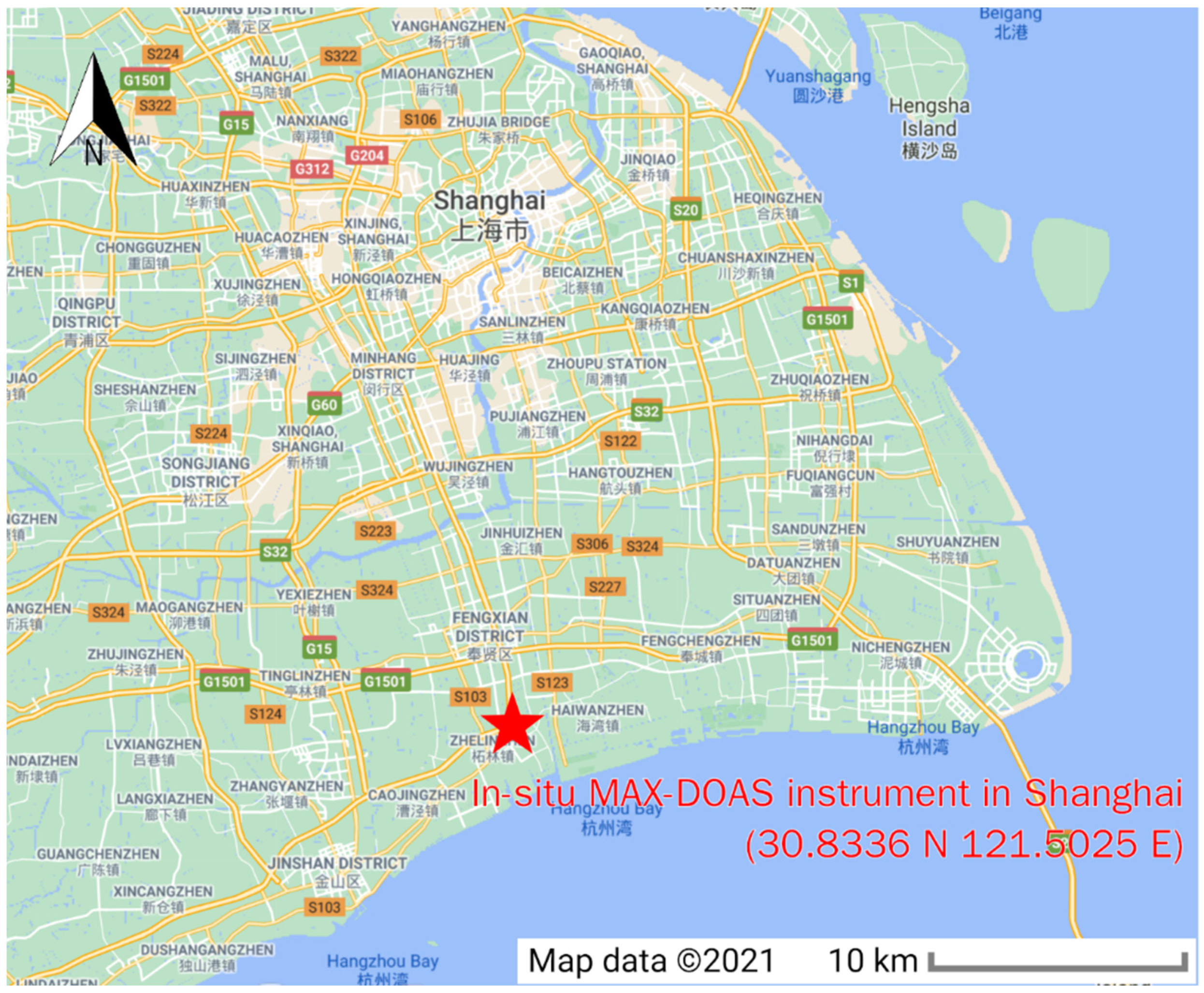

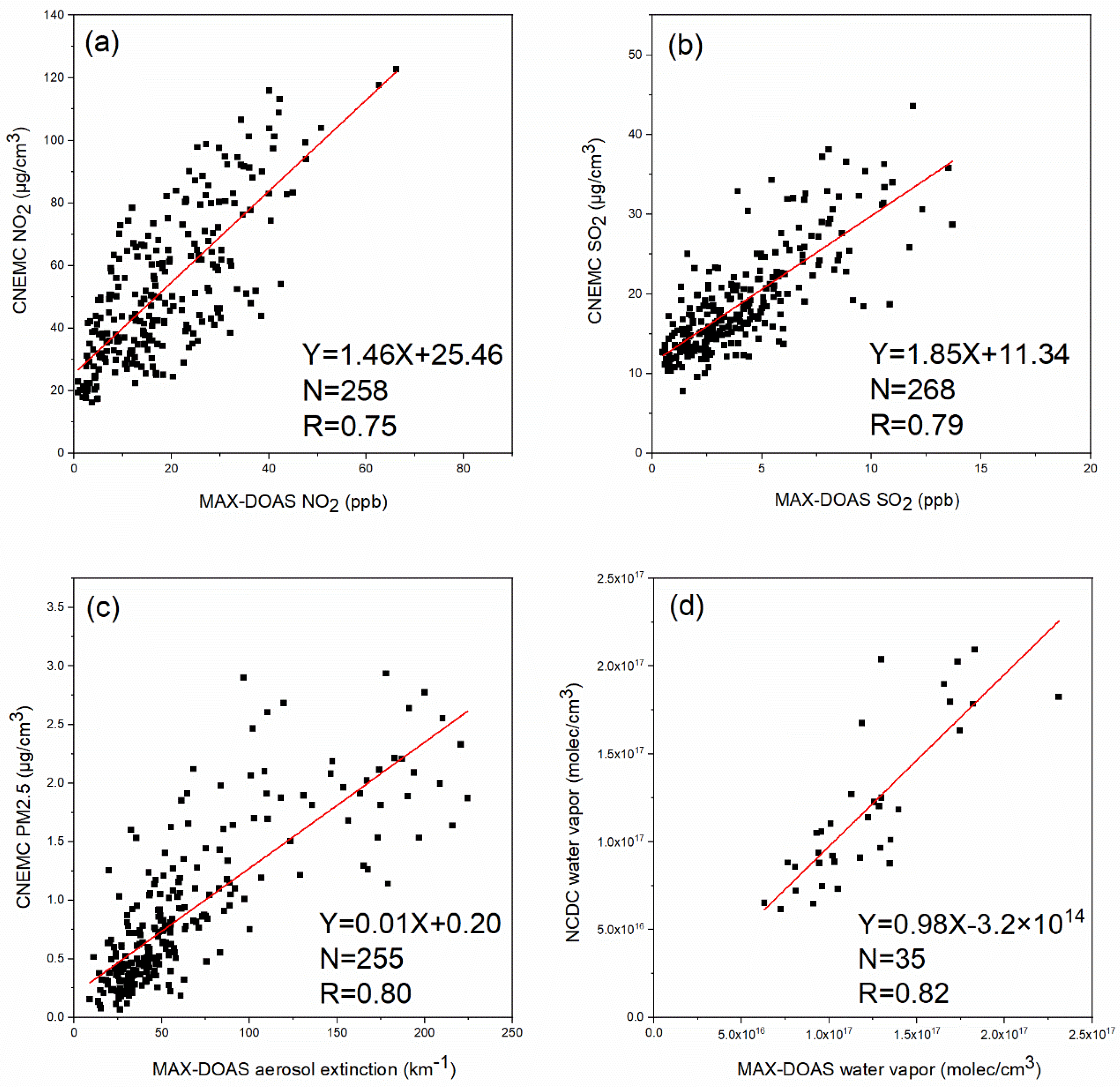


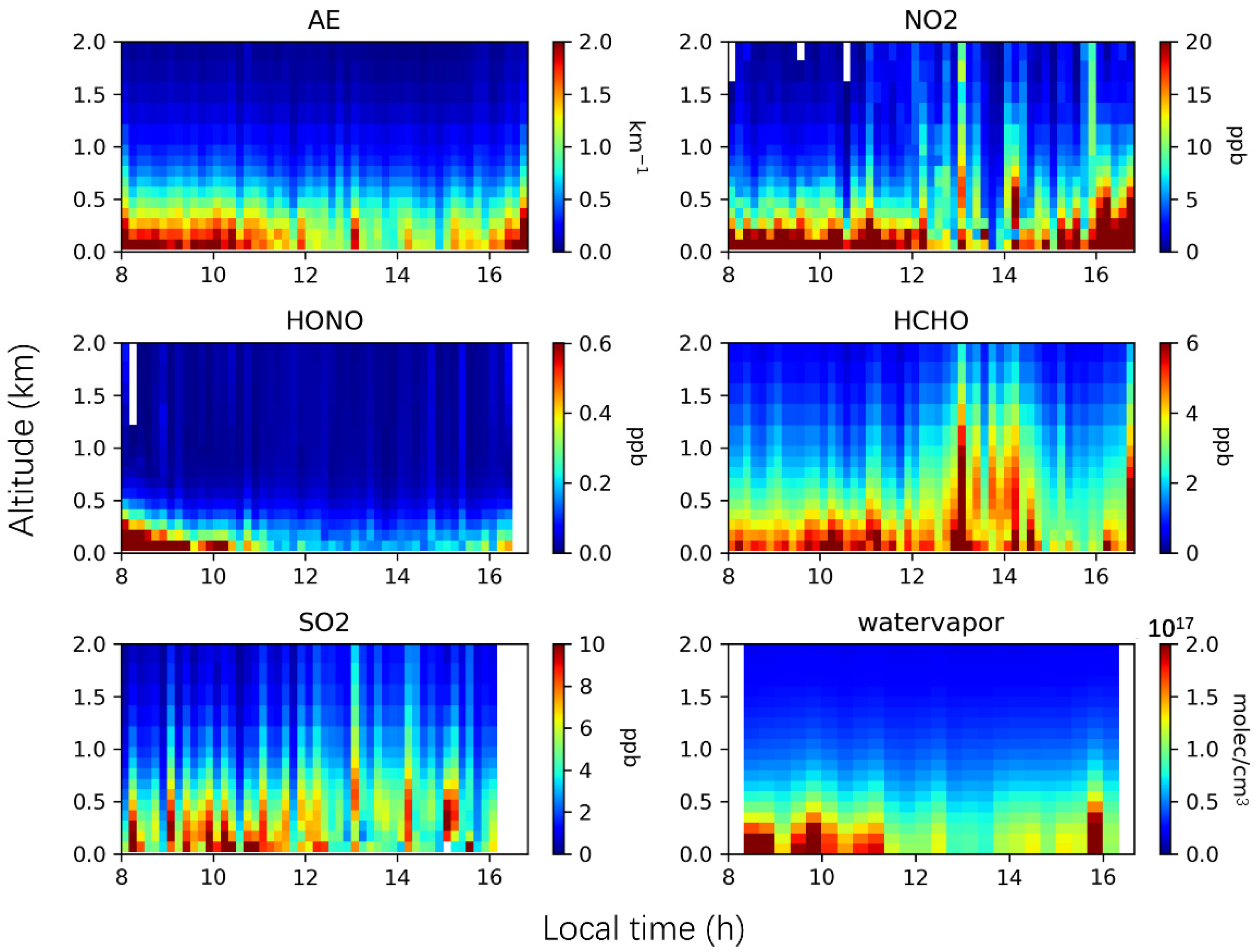
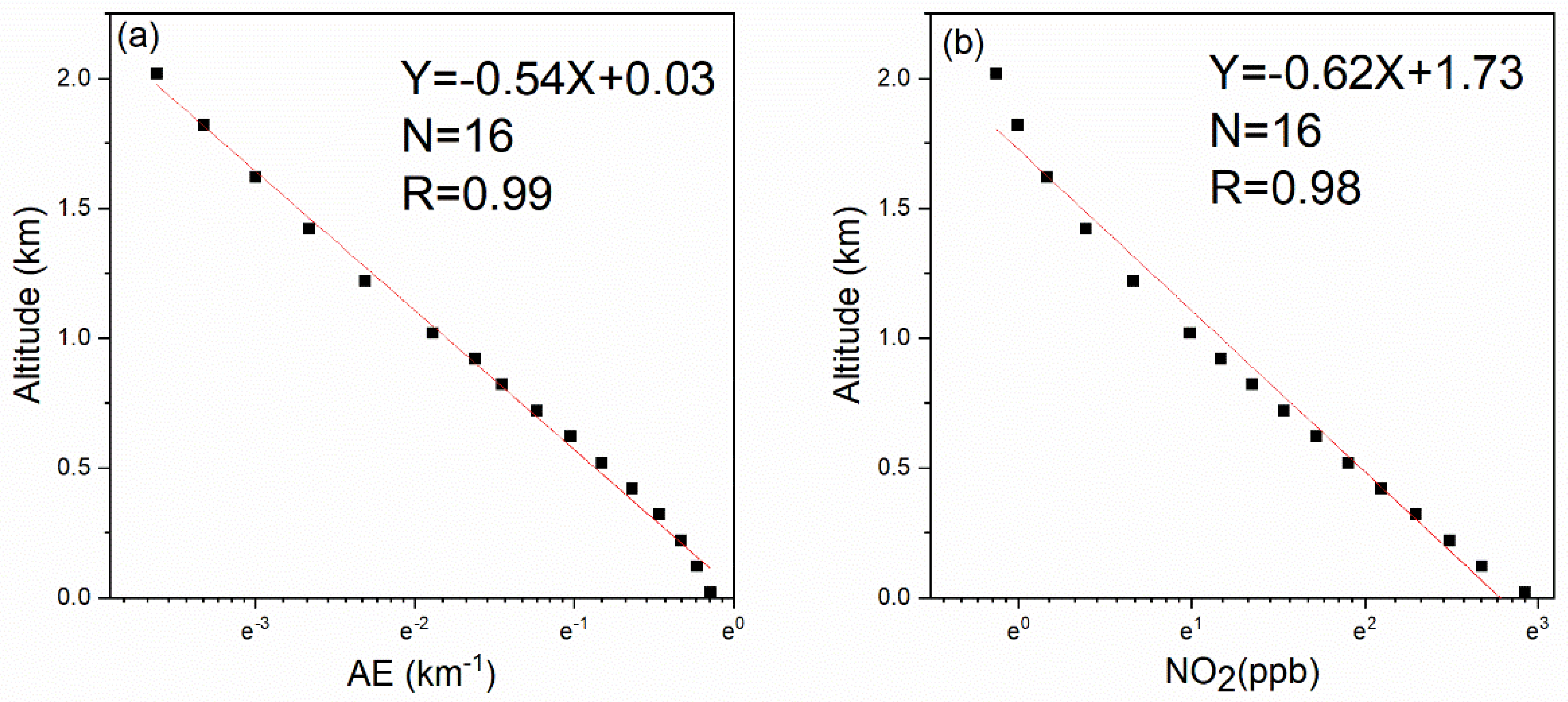
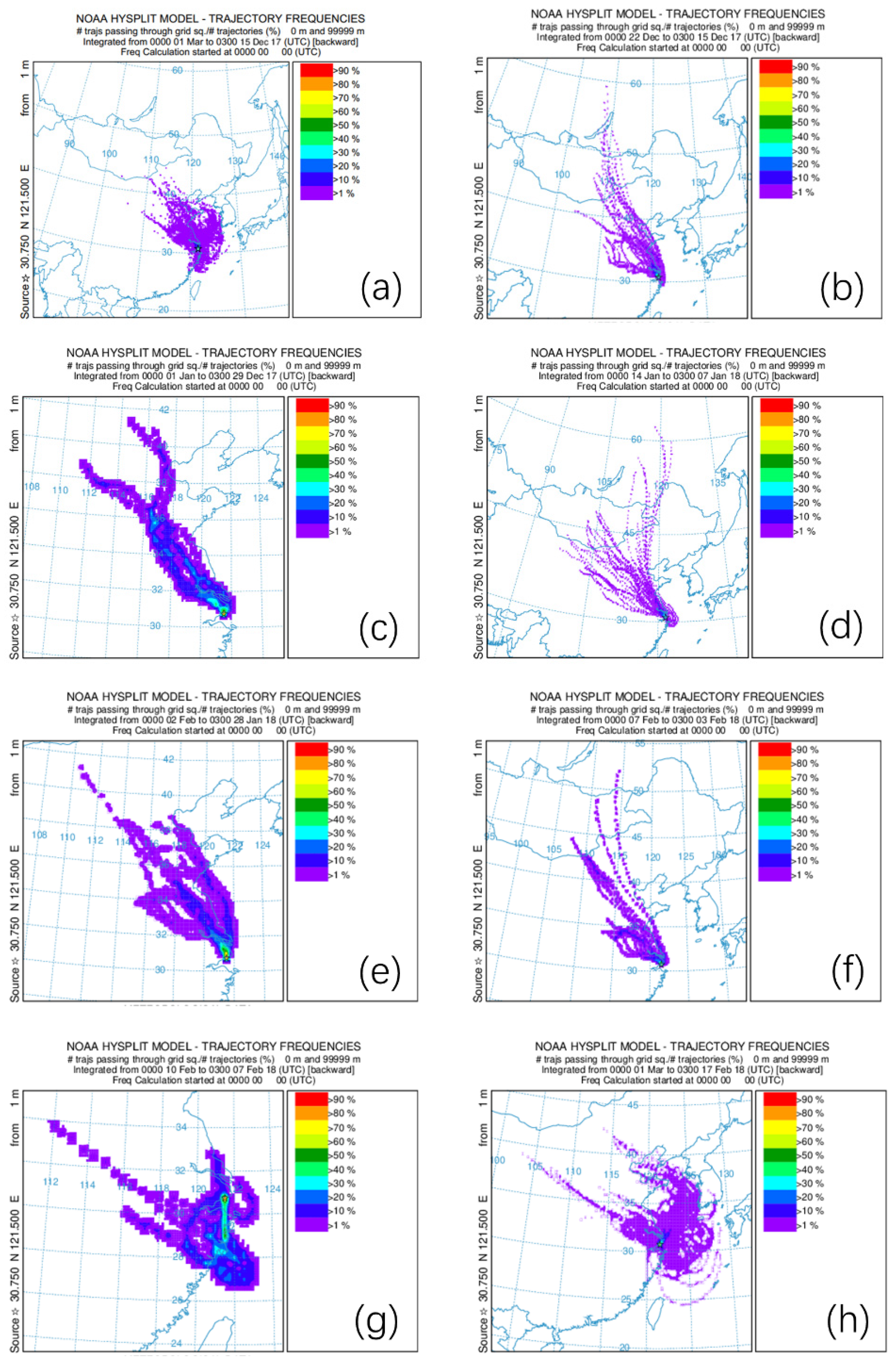


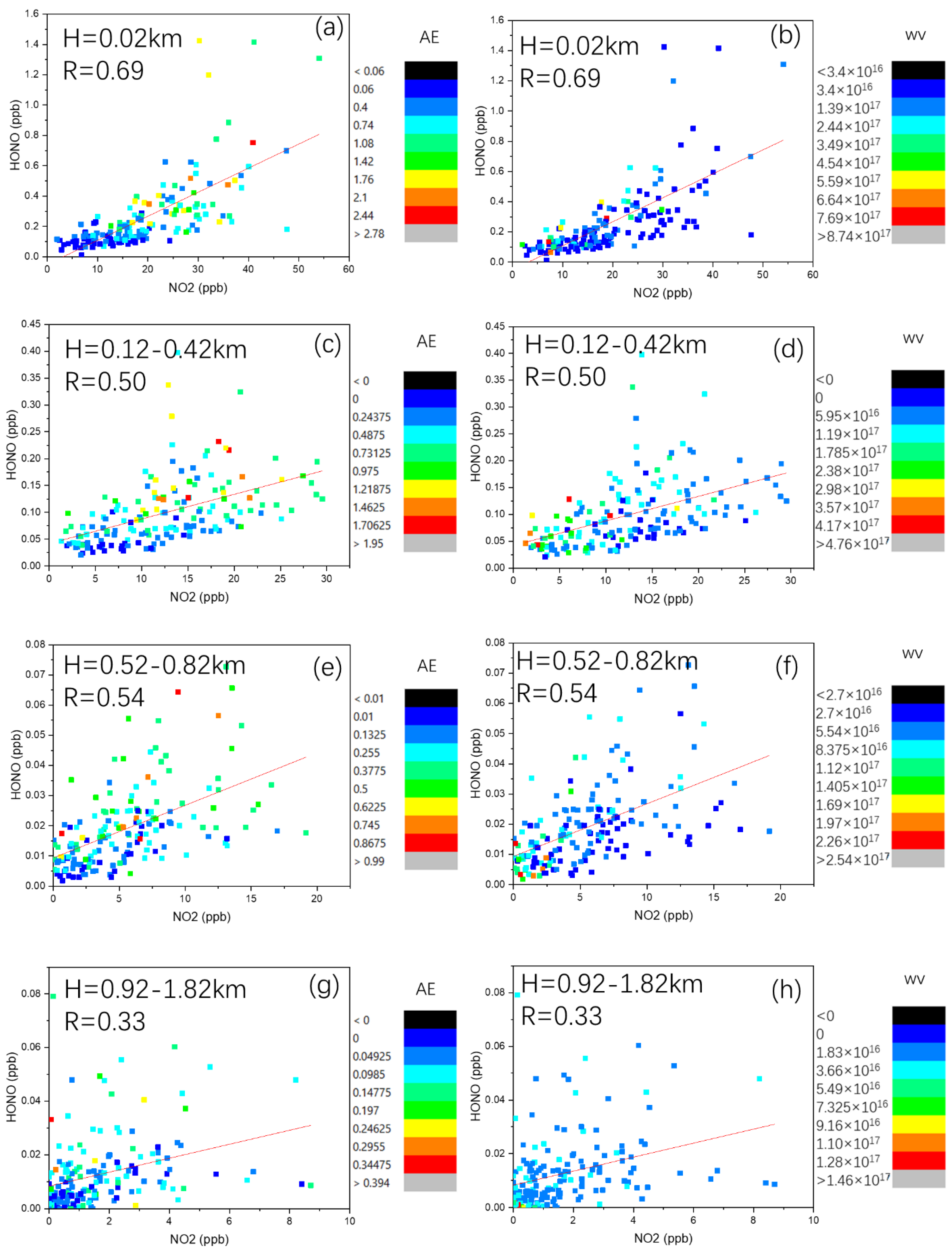
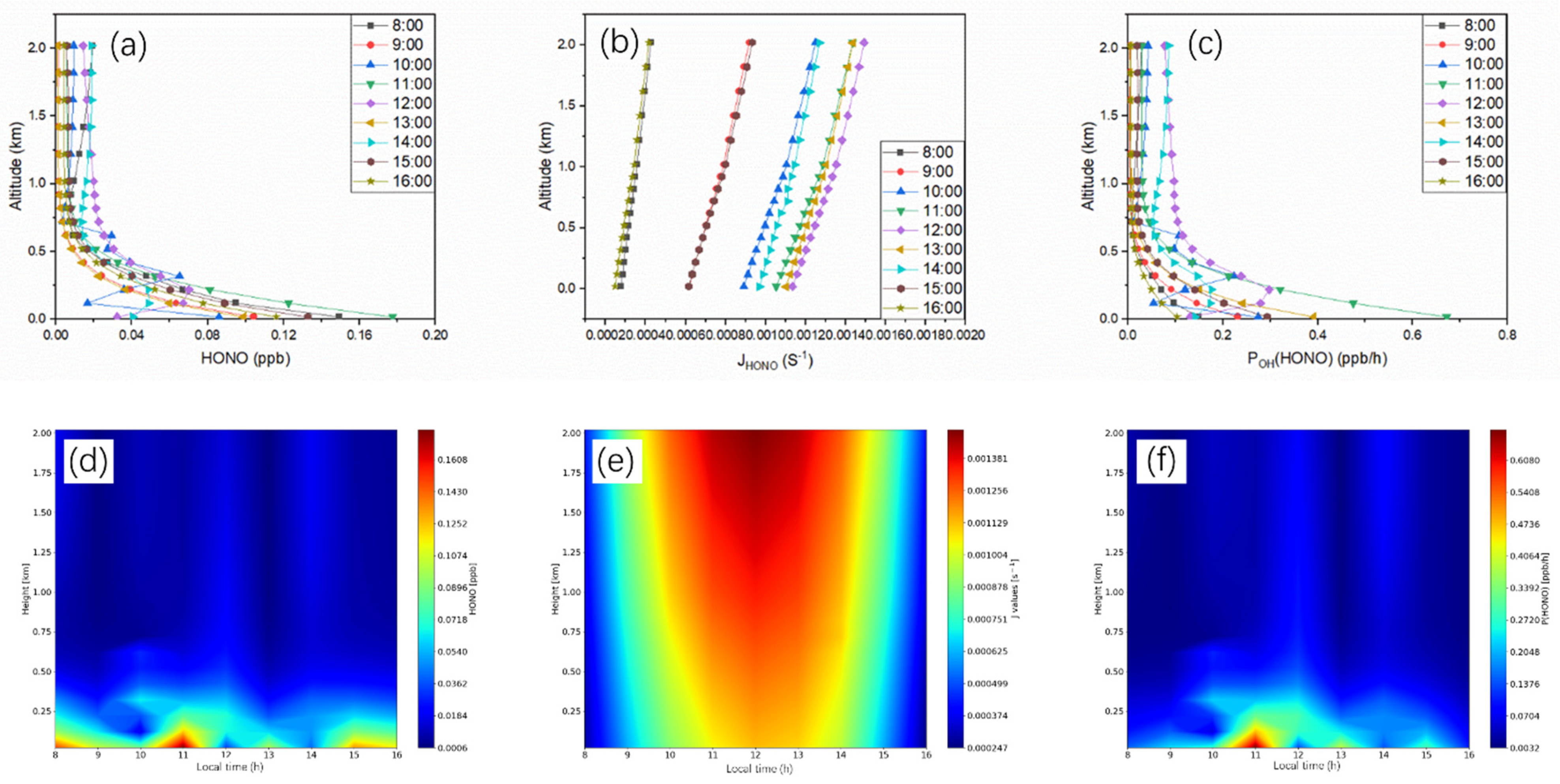
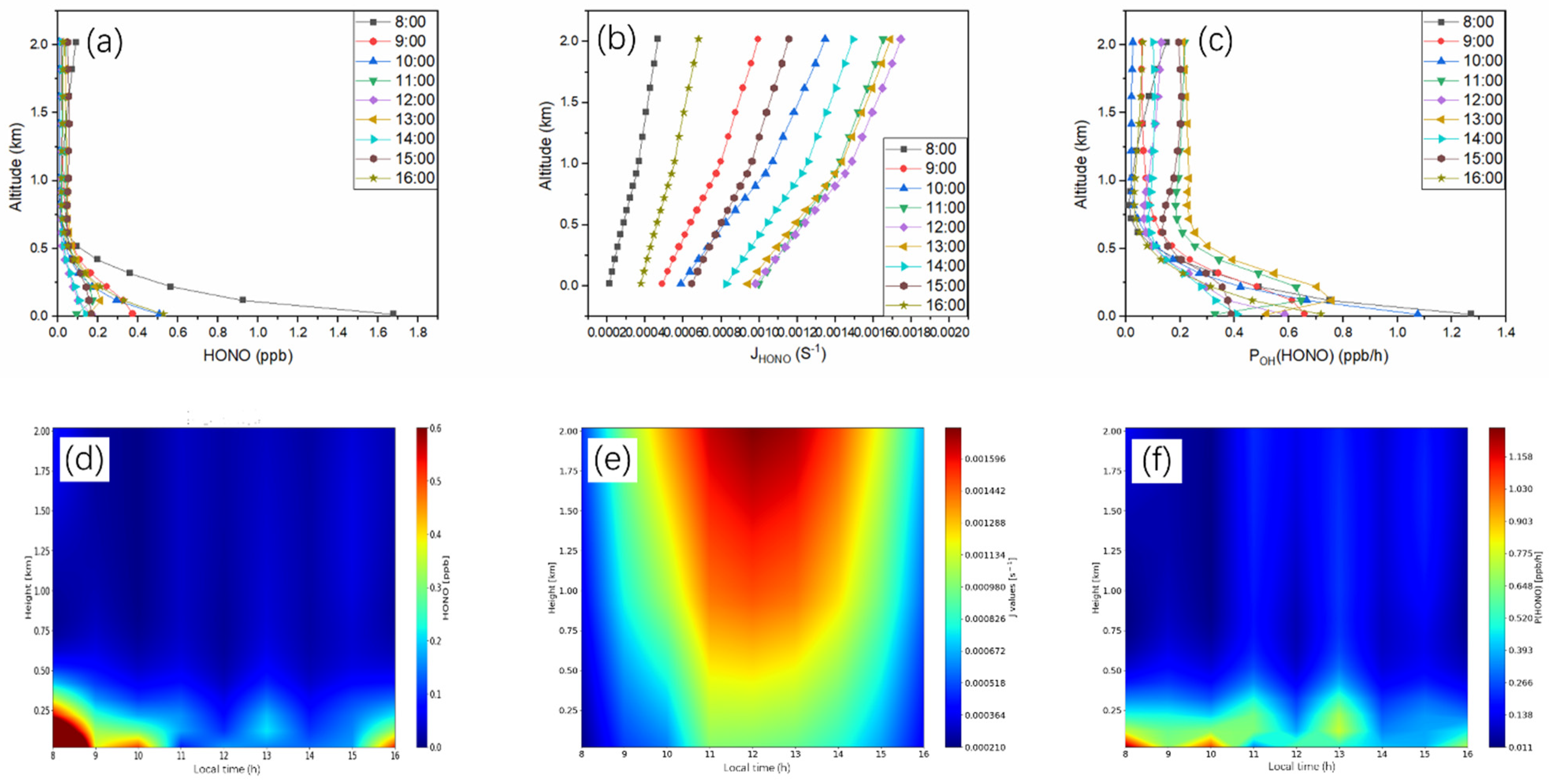
| Parameter | Data Source | Trace Gases | ||||||
|---|---|---|---|---|---|---|---|---|
| O4 | O4 | NO2 | HONO | HCHO | SO2 | H2O | ||
| Fitting Wavelength Range (nm) | 338–367 | 460–490 | 338–367 | 335–373 | 336.5–359 | 307.5–315 | 433–462 | |
| NO2 | [27] 220 K, 294 K, I0-correction * (SCD of 1017 molecules/cm2) | √ | √ | √ | √ | √(294 K) | √(294 K) | √ |
| SO2 | [28] 298 K | √ | ||||||
| HCHO | [29], 297 K | √ | √ | √ | √ | |||
| HONO | [30], 296 K | √ | ||||||
| O3 | [31], 223 K, 243 K, I0-correction * (SCD of 1020 molecules/cm2) | √ | √(223 K) | √ | √ | √ | √ | √(223 K) |
| O4 | [32], 293 K | √ | √ | √ | √ | √ | √ | |
| BrO | [33], 223 K | √ | √ | √ | √ | |||
| Glyoxal | [34], 298 K | √ | ||||||
| H2O | [35], 293 K, 1021 hPa | √ | √ | |||||
| Ring | Ring spectra calculated with QDOAS [36] | √ | √ | √ | √ | √ | √ | √ |
| Polynomial degree | 5th order | 5th order | 5th order | 5th order | 5th order | 5th order | 3rd order | |
| Intensity offset | constant | constant | constant | 1st order | 1st order | 1st order | constant | |
| Wavelength calibration | Based on a high resolution solar reference spectrum (SAO2010 solar spectra) [26] | |||||||
| Type | Site Location | Period | HONO (ppb) Mean ± SD | References |
|---|---|---|---|---|
| Beijing, China (urban) | 3 January–27 January 2016 | 1.05 ± 0.89 | [25] | |
| Ji’nan, China (urban) | December 2015–February 2016 | 1.75 ± 1.62 | [16] | |
| Ground level | Wangdu, China (rural) | June–July 2014 | 0.91 ± 0.48 | [77] |
| observations | Guangzhou, China (urban) | June 2006 | 2.80 | [78] |
| in China | Xinken, China (rural) | 13 October–2 November 2004 | 1.20 | [79] |
| Back Garden, China (rural) | July 2006 | 0.76 | [80] | |
| Shanghai, China (urban) | October 2004–January 2005 | 1.1 ± 1.0 | [81] | |
| Whiteface Mountain, USA (1483 m a.s.l.) | 14 June–20 July 199 | 0.046 | [82] | |
| Hohenpeissenberg, Germany (980 m a.s.l.) | 3 July–12 July 2002 | 0.039 | [83] | |
| Mt.Brocken, Germany (1142 m a.s.l.) | 19 June–4 July 1999 | 0.056 | [84] | |
| Observations at | Northern Michigan (1000–1900 m.) | 30 July-6 August 2007 | 0.009 | [85] |
| high altitude | Northern Italy (300–1000 m a.g.l.) | 12 July 2012 | ~0.15 | [86] |
| Mt. Tai, China (1534 m a.s.l) | November–December 2017 March–April 2018 | 0.15 ± 0.15 0.13 ± 0.15 | [87] |
Publisher’s Note: MDPI stays neutral with regard to jurisdictional claims in published maps and institutional affiliations. |
© 2021 by the authors. Licensee MDPI, Basel, Switzerland. This article is an open access article distributed under the terms and conditions of the Creative Commons Attribution (CC BY) license (https://creativecommons.org/licenses/by/4.0/).
Share and Cite
Xu, S.; Wang, S.; Xia, M.; Lin, H.; Xing, C.; Ji, X.; Su, W.; Tan, W.; Liu, C.; Hu, Q. Observations by Ground-Based MAX-DOAS of the Vertical Characters of Winter Pollution and the Influencing Factors of HONO Generation in Shanghai, China. Remote Sens. 2021, 13, 3518. https://doi.org/10.3390/rs13173518
Xu S, Wang S, Xia M, Lin H, Xing C, Ji X, Su W, Tan W, Liu C, Hu Q. Observations by Ground-Based MAX-DOAS of the Vertical Characters of Winter Pollution and the Influencing Factors of HONO Generation in Shanghai, China. Remote Sensing. 2021; 13(17):3518. https://doi.org/10.3390/rs13173518
Chicago/Turabian StyleXu, Shiqi, Shanshan Wang, Men Xia, Hua Lin, Chengzhi Xing, Xiangguang Ji, Wenjing Su, Wei Tan, Cheng Liu, and Qihou Hu. 2021. "Observations by Ground-Based MAX-DOAS of the Vertical Characters of Winter Pollution and the Influencing Factors of HONO Generation in Shanghai, China" Remote Sensing 13, no. 17: 3518. https://doi.org/10.3390/rs13173518
APA StyleXu, S., Wang, S., Xia, M., Lin, H., Xing, C., Ji, X., Su, W., Tan, W., Liu, C., & Hu, Q. (2021). Observations by Ground-Based MAX-DOAS of the Vertical Characters of Winter Pollution and the Influencing Factors of HONO Generation in Shanghai, China. Remote Sensing, 13(17), 3518. https://doi.org/10.3390/rs13173518








